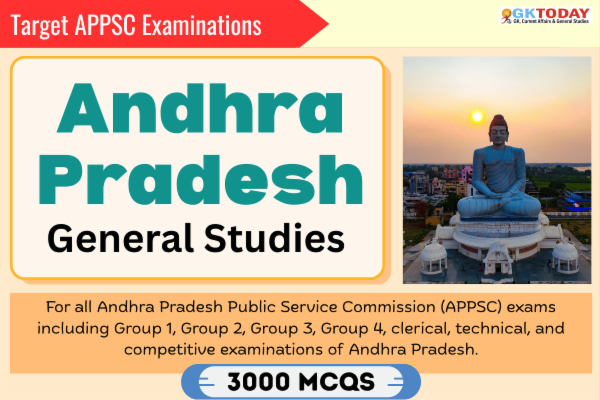States PCS: Andhra Pradesh GK For APPSC Examinations
For all Andhra Pradesh Public Service Commission (APPSC) exams including Group 1, Group 2, Group 3, Group 4, clerical, technical, and competitive examinations of Andhra Pradesh.
31. Who was the first chairman of the Press Academy of Andhra Pradesh?
[A] Devireddy Sreenath
[B] K. Srinivasa Reddy
[C] Chandrababu Naidu
[D] Y. S. Rajasekhara Reddy
Show Answer
Correct Answer: B [K. Srinivasa Reddy]
Notes:
K. Srinivasa Reddy was the inaugural chairman of the Press Academy of Andhra Pradesh, established in 1996.
32. Which dynasty defeated the Western Satraps and is notably linked with the practice of overstriking coins in ancient India?
[A] Ikshvakus
[B] Abhiras
[C] Satavahanas
[D] Vakatakas
Show Answer
Correct Answer: C [Satavahanas]
Notes:
The Satavahanas overstruck coins of Western Satraps, symbolizing their victory and control over Satrap minting and trade.
33. During the Satavahana period in Andhra Pradesh, which religion, apart from Brahmanism, received considerable royal patronage?
[A] Jainism
[B] Shaivism
[C] Buddhism
[D] Vaishnavism
Show Answer
Correct Answer: C [Buddhism]
Notes:
The Satavahana rulers patronized both Brahmanism and Buddhism, evident from major Buddhist sites like Amaravati and Nagarjunakonda constructed or expanded during their reign.
34. Which system, introduced during the Kakatiya dynasty in Telangana, involved granting land to warrior chiefs in exchange for military service?
[A] Samanta System
[B] Nayankara System
[C] Jagirdari System
[D] Poligari System
Show Answer
Correct Answer: B [Nayankara System]
Notes:
The Nayankara system assigned land to Nayakas (warrior chiefs) for military service; it became central to Kakatiya administration and influenced later South Indian kingdoms.
35. In which district of Andhra Pradesh is Kamavarapukota located?
[A] Visakhapatnam
[B] Eluru
[C] Guntur
[D] Chittoor
Show Answer
Correct Answer: B [Eluru]
Notes:
Kamavarapukota, in Eluru district, Andhra Pradesh, is known for Guntupalli Hills, ancient Dwaraka Tirumala pilgrimage site, Buddha caves, and the thousand-year-old Sree Badhrakali Veerabadhra Swamy Temple at Kota Gattu, a historically significant fortress area.
36. Which ancient ruler is associated with the Buddhist monuments found at Jeelakargudem in Chintalapudi, Andhra Pradesh?
[A] Ashoka
[B] Chandragupta Maurya
[C] Harsha
[D] Samudragupta
Show Answer
Correct Answer: A [Ashoka]
Notes:
Chintalapudi, a town in Eluru district, Andhra Pradesh, dates back to 600-300 BC with ancient Buddhist monuments at Jeelakargudem linked to Ashoka’s reign. The region is notable for oil palm cultivation, contributing 50-60% of district production, and potential coal reserves.
37. What is the primary rock type composing the Palkonda Hills in Andhra Pradesh?
[A] Granite
[B] Basalt
[C] Shale
[D] Quartzite
Show Answer
Correct Answer: D [Quartzite]
Notes:
Palkonda Hills, part of the Eastern Ghats in Andhra Pradesh, run northwest to southeast through Anantapur and Kadapa districts, averaging 2,000 ft elevation. Composed mainly of quartzite, they date back to the Cambrian period and host teak forests and Jerdon’s courser habitat.
38. In which year was Sri Venkateswara University, Tirupati, Andhra Pradesh established?
[A] 1968
[B] 1954
[C] 1946
[D] 1970
Show Answer
Correct Answer: B [1954]
Notes:
The university was established in 1954 in Tirupati, Andhra Pradesh. It is a state university accredited by NAAC with A+ grade.
39. During which movement did Ramaswamy Chowdary compose the Telugu lyric “Viragandhamu Techinamaramu–Virulevaro Telapandi”?
[A] Quit India Movement
[B] Civil Disobedience Movement
[C] Non-Cooperation Movement
[D] Swaraj Movement
Show Answer
Correct Answer: B [Civil Disobedience Movement]
Notes:
The lyric was composed by Ramaswamy Chowdary during the Civil Disobedience Movement (1930–34) in Andhra Pradesh to inspire resistance and regional participation in the freedom struggle.
40. In which year was the First Andhra Mahasabha held?
[A] 1913
[B] 1916
[C] 1920
[D] 1924
Show Answer
Correct Answer: A [1913]
Notes:
The First Andhra Mahasabha was held at Bapatla in April 1913, uniting Telugu-speaking elites and laying the foundation for the Andhra Movement and eventual formation of Andhra State.

